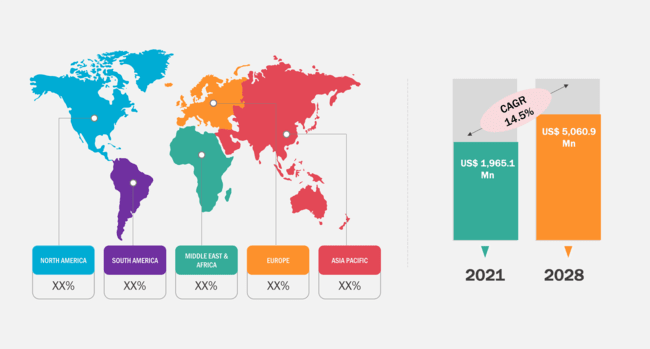Structural Health Monitoring Market size is expected to reach US$ 5,060.9 Million by 2028; registering at a CAGR of 14.5% During 2022–2028, according to a new research study conducted by The Insight Partners.
Development of smart cities is Catalyzing the Structural Health Monitoring Market

Structural Health Monitoring Market Size - Growth, Share by 2031
Download Free SampleStructural Health Monitoring Market Size and Forecasts (2021 - 2031), Global and Regional Share, Trends, and Growth Opportunity Analysis Report Coverage: by Component (Hardware, Software and Services); Connectivity (Wired Structural Health Monitoring and Wireless Structural Health Monitoring); End-User (Oil and Gas, Civil Infrastructure, Aerospace and Defense, Energy, Mining, and Others), and Geography (North America, Europe, Asia Pacific, and South and Central America)
Source: The Insight Partners Analysis
Structural health monitoring (SHM) is the process of monitoring a system using the periodically sampled response measurements captured by a range of sensors. Data acquisition, operational evaluation, normalization, and cleansing; feature extraction; data compression; and statistical model development are among the different processes included in structural health monitoring. Sensors, data transfer and storage systems, data management systems, data acquisition systems, and data interpretation and diagnosis systems are the key components of structural health monitoring systems. These systems are also for the damage detection of buildings, bridges, and other engineering structures. The dense populations of a few Asian countries, such as India and China, have paved the way for rapid urbanization, thus, leading to an increased focus on infrastructure growth and development. In the last few years, a large number of companies have started offering structural health monitoring solutions for various projects worldwide.
North America led the structural health monitoring market in 2021. The presence of a large number of market players in the region is one of the major factors driving the growth of the market in this region. These solutions are aggressively being adopted in the US and various European countries, such as Germany, the UK, and France. However, countries in Asia Pacific—such as China, India, Japan, and Singapore—and the Gulf Corporation Council (GCC) countries—such as the Saudi Arabia, the UAE, and Qatar—present huge growth potential for the structural health monitoring market. This is due to the increasing infrastructural investments in bridges, utilities, buildings, and tunnels in these countries. Various development programs have been launched in these regions for the development of bridges, tunnels, etc. For instance, Abu Dhabi Strategic Tunnel Enhancement Programme aims at providing improved wastewater systems. In addition, various initiatives taken by governments for the development of smart cities, especially in India and Africa, are expected to provide lucrative growth opportunities for the structural health monitoring market players. For instance, Smart Cities India Expo 2022 aims at combining technologies with clean energy infrastructure, green buildings, water distribution systems, urban mobility, and smart ICT, which are crucial pillars of urban development, for the proper optimization of resources to make cities sustainable and smarter. Structural health monitoring system deployment would play an important role in the development of smart cities and monitoring of structures such as roads, tunnels, and buildings.
A large number of construction companies, marine and air traffic departments, and government bodies/associations are promoting the adoption of structural health monitoring solutions/devices for reducing the expenses associated with infrastructural repairs. Moreover, the economic growth of developing countries in Southeast Asia and the Middle East & Africa, adoption of advanced technologies, and increasing implementation of organic and inorganic growth strategies by market players are bolstering structural health monitoring market growth. For instance, in November 2020, Sixense, a France-based company, partnered with Topcon Positioning Systems (US) for expanding its presence in Africa. Through this partnership, Sixense aims to meet the requirements for digital transformation in the infrastructure, mining, construction, and agriculture sectors in Africa.
Acellent Technologies, Inc.; Campbell Scientific, Inc.; Digitex; Geocomp Corporation; HBM; James Fisher and Sons plc; Kinemetrics; Nova Ventures; Resensys, LLC; and SIXENSE Systems are key players in the structural health monitoring market. In addition to these, several other major companies—including Xylem Inc.; SGS S.A.; Structural Monitoring Systems plc.; and Pure Technologies have been studied and analyzed during this research study to get a holistic view of the market. The market players are majorly focusing on launching innovative monitoring solutions that help harvest energy from various renewable energy sources, such as solar and wind; and reducing the amount of energy utilized by structural health monitoring systems. For example, in March 2015, Sorin Group partnered with various research institutes and universities for the development of autonomous energy harvesting wireless sensor modules, majorly for applications in marine and aircraft infrastructure projects. Similarly, in April 2020, Campbell Scientific launched GRANITE series, a structural health monitoring data acquisition system (DAS). These structural health monitoring measurement modules improve the flexibility of the system and enable channel expansion.
Contact Us Phone: +1-646-491-9876Email Id: sales@theinsightpartners.com